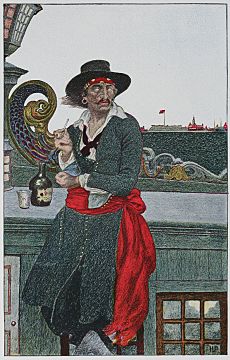Richard Coote, 1st Earl of Bellomont facts for kids
Quick facts for kids
The Earl of Bellomont
|
|
|---|---|
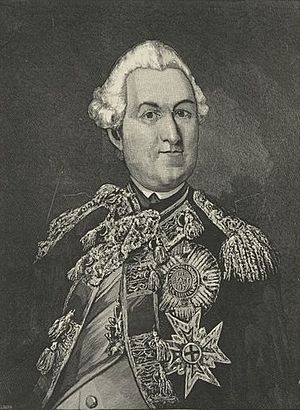
Engraved portrait of the earl, c. 1888
|
|
| 12th Governor of the Province of New York | |
| In office 1698–1700/01 |
|
| Monarch | William III and Mary II |
| Preceded by | Benjamin Fletcher |
| Succeeded by | John Nanfan (acting) |
| 2nd Governor of the Province of Massachusetts Bay | |
| In office 26 May 1699 – 17 July 1700 |
|
| Preceded by | William Stoughton (acting) |
| Succeeded by | William Stoughton (acting) |
| Governor of the Province of New Hampshire | |
| In office 31 July 1699 – c. 15 August 1699 |
|
| Preceded by | Samuel Allen |
| Succeeded by | William Partridge (acting) |
| Personal details | |
| Born | 1636 Ireland |
| Died | 5 March 1701 (aged 64–65) Province of New York |
Richard Coote, 1st Earl of Bellomont (1636 – 5 March 1701) was an Irish nobleman and important leader. He was known as The Lord Coote from 1683 to 1689. He served in the English Parliament for Droitwich from 1688 to 1695.
Richard Coote strongly supported William III and Mary II. He helped them during the Glorious Revolution in 1688. In 1695, he became governor of the English colonies of New York, Massachusetts Bay, and New Hampshire. He held these jobs until he died.
He arrived in North America in 1698. He spent most of his time as governor in New York. He stayed in Massachusetts for just over a year and in New Hampshire for only two weeks. In New York, he faced political problems from Leisler's Rebellion. He also had difficult talks with the Iroquois people. He tried to stop them from making peace with New France.
In Massachusetts and New Hampshire, his main concerns were about timber and safety from the Abenaki people. He also helped fund William Kidd, a privateer who later became a pirate. Bellomont arranged for Kidd's arrest in Boston. Kidd was sent back to England for trial.
Contents
Early Life and Political Beginnings
Richard Coote was born in 1636 in Cootehill, County Cavan, Ireland. He was the second son in his family. His father became Baron Coote of Coloony in 1660. Richard became Baron Coote when his father died in 1683.
Not much is known about his early life. In 1680, he married Catherine. They had two sons together.
When James II, a Catholic, became king, Coote, who was Protestant, moved to Europe. He served as a captain in the Dutch army. King James II called him back to England in 1687. Coote was one of the first to join William of Orange in the Glorious Revolution of 1688. This event brought William III and Mary II to the throne.
Because of his loyalty, Coote was made Treasurer to the Queen in 1689. He held this job until 1694. The Irish Parliament, which still supported James, took away his lands. So, King William made him Earl of Bellomont on November 2, 1689. He also gave him a large amount of land in Ireland. This land grant caused much debate in Parliament. It was later taken back by William. He also became governor of County Leitrim.
Bellomont was a Member of Parliament for Droitwich from 1688 to 1695. In the 1690s, he helped Jacob Leisler's son. Leisler had led a rebellion in New York. He was later arrested and executed. His son, Jacob Jr., went to England to get his family's property back. Bellomont was on the committee that looked into the case. He spoke in Parliament to support Leisler's family. He believed Leisler had been treated unfairly. Young Leisler's efforts worked. Parliament decided to give the family's property back.
Serving as a Colonial Governor
In 1695, the governor of Massachusetts Bay, Sir William Phips, died. People wanted a local person to be the new governor. But the king chose Bellomont instead. The king wanted someone who would better represent the crown's power. Bellomont was also made governor of New Hampshire and New York. His main task was to stop piracy. Pirates were openly trading in New York City and Rhode Island.
Bellomont's appointments were finalized in June 1697. During this time, a New York agent named Robert Livingston suggested a plan. He proposed outfitting a privateer ship to fight pirates. He recommended William Kidd as the captain. King William agreed to this plan. He gave Kidd a special permission to deal with pirates. Bellomont helped raise money for Kidd's ship. He put in £1,000 of his own money.
Governor of New York
Bellomont sailed for New York in late 1697 with his wife. His ship faced a bad storm. It ended up in Barbados before reaching New York. He arrived in New York City on April 2, 1698. New Yorkers liked him at first because of his good looks and royal connections. But he soon faced problems and made enemies.
He tried to enforce the Navigation Acts. These laws controlled trade. This made merchants and traders angry. Colonial officials did not help much. Their interests were more with the merchants than with the king. Bellomont also angered those who opposed Leisler. He helped restore Leisler's properties, as Parliament had ordered. Many on his council were against this. He removed those who opposed him from the council. Bellomont also arranged for Leisler's remains to be properly buried. He provided an honor guard for the service.
Bellomont's support for Leisler's followers caused problems. It affected not only New York politics but also relations with Native American groups. Benjamin Fletcher, the previous governor, had made questionable land grants. Some of these were in lands claimed by the Iroquois. Bellomont's assembly passed a law to cancel these grants. This angered many large landowners. Land grants to Godfridius Dellius, a pastor in Albany, were a big problem for the Iroquois. Even though Bellomont's law passed, the landowners appealed. The king never approved the law.
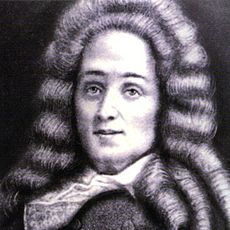
Bellomont did not let Dellius and others deal with the Iroquois. This meant New York lost experienced negotiators. This hurt Iroquois politics. Their leaders who supported working with the English lost power. This happened at a sensitive time. Bellomont was trying to strengthen the Covenant Chain. This was an alliance that Fletcher had ignored.
After the Treaty of Ryswick ended the war between France and England in 1697, the French continued to fight the Iroquois. The Iroquois asked the English for help. They threatened to make peace with the French if they did not get it. Bellomont and French Governor General Louis-Hector de Callière both claimed control over the Iroquois. Neither would let the other speak for them. In 1699, Callière called the Iroquois to Montreal for talks. Bellomont sent someone to Montreal and troops to Albany. He managed to stop the Iroquois from going. But French-allied Native Americans attacked Iroquois land in 1700.
Bellomont sometimes overlooked Iroquois customs in talks. This led to misunderstandings. Bellomont thought the talks went well. But the Iroquois leaders were unhappy. He promised to build a fort at Onondaga. He even got money from the legislature for it. But the Iroquois did not fully accept this "gift." They never showed English engineers where to build the fort. Bellomont tried to stop the Iroquois from dealing with the French. But French military wins in 1700 led to the Great Peace of Montreal in 1701.
Governor of Massachusetts and New Hampshire
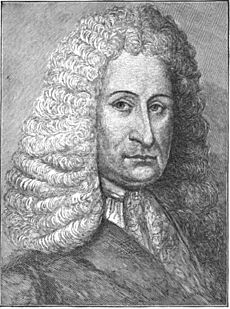
In May 1699, Bellomont sailed to Boston. He spent 14 months in New England. He was in New Hampshire for a few weeks and the rest of the time in Massachusetts. In Massachusetts, people were polite to him. But his plans to carry out the king's policies faced problems. The colonial legislature refused to pay him a salary. However, they gave him a "gift" of £1,000. This was more than other governors usually received. The legislature also tried to limit appeals of court decisions to London. Bellomont had to send laws to the Board of Trade for approval. Many of these laws were rejected. They tried to limit the king's power. Bellomont also sided with the popular leader Elisha Cooke Sr.. He was against Lieutenant Governor William Stoughton.
Soon after arriving in Boston, Bellomont arranged for William Kidd's arrest. Rumors had spread that Kidd had become a pirate. Bellomont and other investors in Kidd's ship saw him as a problem. In November 1698, the Admiralty ordered all governors to arrest Kidd. In June 1699, Bellomont learned Kidd was nearby. He sent a message to Kidd, promising to be lenient. Kidd agreed to come. He sent some of his treasures as a gift to Lady Bellomont, but she refused them.
Kidd arrived in Boston on July 3. Bellomont asked Kidd for a written account of his travels. Kidd agreed to provide it on July 6. When he did not, Bellomont issued an arrest warrant. Kidd was arrested that same day. Kidd tried to make a deal for his freedom. He offered to reveal where his treasure was hidden. Some of Kidd's treasure was found. But it did not buy his freedom. He was sent to London in April 1700. There, he was tried and found guilty. He was later executed. Bellomont was very careful in his dealings with other suspicious merchants and pirates. He refused large sums of money to ignore illegal activities.
Issues about frontier safety and the lumber trade were important during his time in New England. New England was a key source of ship masts for the Royal Navy. The government wanted to save suitable trees for the king. In both colonies, Bellomont faced opposition. Landowners and timber companies did not like surveyors on their land. They also took lumber from lands that belonged to the crown.
In New Hampshire, the timber problem was linked to land disputes. Local landowners were fighting Samuel Allen. Allen was a London merchant who claimed land from the heirs of John Mason, the colony's founder. Allen became governor in 1692. He came to the colony in 1698 to manage his affairs directly. During Bellomont's visit to New Hampshire in 1699, Allen tried to get him on his side. Allen offered his daughter to Bellomont's son for marriage. Bellomont refused this unusual offer.
Abenaki Relations
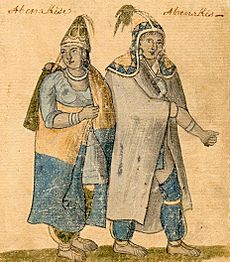
The situation on the frontier was tense when Bellomont was in Massachusetts and New Hampshire. The Abenaki people of northern New England were not part of the Treaty of Ryswick. This treaty ended King William's War. After the war, the Abenaki and settlers in Maine and New Hampshire did not trust each other. The Abenaki felt their lands were being taken. English colonists feared attacks from French-supported Native Americans. Bellomont issued statements to the Abenaki. He said there were no plans to take their lands. But he could not ease the tension.
One reason was his belief that Abenaki concerns were part of a French Catholic plot. English negotiators tried to separate the Abenaki from their Jesuit missionaries. This hurt trade talks. It also did not calm New Englanders' fears about "Popish Emissaries" causing war. The colonial legislature passed a law banning Roman Catholics from lands claimed by the province. This included Abenaki territory. Bellomont tried to convince the eastern Abenaki to move west. He wanted them to be influenced by the Iroquois. This did not work. The Abenaki and Iroquois had a history of conflict. Despite these problems, he achieved a fragile peace with the Abenaki in January 1699.
Relations with the Abenaki were also complex due to different ideas about who was in charge. The Abenaki saw themselves as independent. The English believed they were subjects, either to them or to the French. A prisoner exchange was difficult. Bellomont thought he only needed to talk to the governor in Quebec to get English prisoners released.
Return to New York and Death
Bellomont returned to New York in 1700. He continued his efforts against piracy and illegal shipping. He had a meeting with the Iroquois in Albany in early 1701. Bellomont described it as the "greatest fatigue [I] ever underwent." He then returned to New York City. He died there on March 5, 1701, from a severe case of gout. He was buried in the chapel of Fort William. Later, his remains were moved to the yard of St. Paul's Chapel.
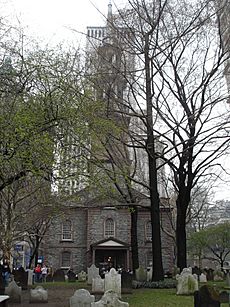
Lieutenant Governor Nanfan took over as New York's governor. He served until Lord Cornbury arrived in 1702. Nanfan achieved a peace agreement that Bellomont could not. In 1701, the Iroquois signed the Nanfan Treaty. This agreement placed their western lands under the English crown's protection. These lands stretched from present-day Erie, Pennsylvania to Chicago and northern Michigan.
Family and Legacy
Bellomont's oldest son, Nanfan, became the 2nd Earl of Bellomont after his father's death. His second son, Richard, became the 3rd earl when Nanfan died. When the 3rd earl died without sons, the earldom ended. The barony then passed to his cousin, Sir Charles Coote. He was also later made Earl of Bellomont. He died without sons, and all the titles then ended.
Bellomont's time as governor in New York was not remembered well. One political opponent said that Bellomont's memory "will stink in the nostrills of all good men." Robert Livingston reported that the colony's debt grew very large. Bellomont's personal finances were also complicated. His creditors tried to stop his wife from leaving the colony. They wanted her to settle his personal debts. Bellomont's financial problems were not unique. Later governors also faced accusations of wrongdoing and personal debt. New York's debt problems were not solved until the Hunter administration in 1717.


